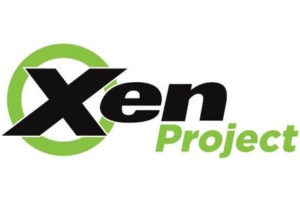 The Xen Project, an open source hypervisor hosted at the Linux Foundation, today announced the release of Xen Project Hypervisor 4.12. This latest release adds impressive feature improvements around security and code size, x86 architectural renewal and additional updates making the technology ideal for embedded and automotive industries.
The Xen Project, an open source hypervisor hosted at the Linux Foundation, today announced the release of Xen Project Hypervisor 4.12. This latest release adds impressive feature improvements around security and code size, x86 architectural renewal and additional updates making the technology ideal for embedded and automotive industries.
The leaner architecture in Xen 4.12 reduces the lines of code and in turn, reducing the potential for security vulnerabilities while making Xen an attractive option for use in mixed-criticality systems. Additionally, improving de-privileged QEMU, through defense-in-depth techniques, as well as improving VMI, reduces exposure to unknown security threats. This version of Xen will be more configurable, significantly reducing integration costs for business and organizations which customize Xen heavily. Additionally, Xen 4.12 continues to build upon previous versions regarding cleaner architecture, improved user experience, and future proofing.
“Xen Project Hypervisor 4.12 is a clear example of the project delivering on its promise for revamped architecture, a major step forward to unlock market segments such as security products as well as embedded and automotive,” said Lars Kurth, chairperson of the Xen Project Advisory Board. “As we continue to serve the hosting and cloud markets, we will also focus on streamlining the certification process for Xen while helping the security embedded automotive vendors that are invested in Xen continue to build attractive products on top of the hypervisor.”
Security & Code Size
The Xen 4.12 release builds upon the security features of previous releases, continuing Xen’s legacy of being the safest and most stable hypervisor for security-focused environments.
- HVM/PVH and PV only Hypervisor: The new Xen Project 4.12 release separates the HVM/PVH and PV code paths in Xen and provides KCONFIG options to build a PV only or HVM/PVH only hypervisor. This enables Xen based security products such as Qubes OS, Star Lab Crucible, & OpenXT to more easily build products with vastly reduced memory footprint and attack surface. In addition, the release enables cloud and hosting providers which do not offer support for PV guests to deploy HVM/PVH only hypervisors which in turn, increases security.
- QEMU Deprivilege (DM_RESTRICT): Xen’s previous three releases laid the groundwork for the QEMU Deprivilege, limiting the impact of security vulnerabilities that originate QEMU. In Xen 4.12, this feature has been vastly improved. The majority of restrictions and features have been implemented, improving security and readiness for wide-scale testing. Support for VM migration has also been added and defense-in-depth techniques using chroot, RLIMITs, and Linux namespaces which are used to protect against privilege escalations from QEMU to Xen and VM’s.
- Argo – Hypervisor-Mediated data eXchange: Argo is a new inter-domain communication mechanism that is designed for security, safety and mixed-criticality systems with isolation properties that go beyond those of existing inter-domain communication mechanisms. Argo is designed to be robust and simple to use correctly, securely and safely. In addition, Argo meets requirements for performance isolation between domains, to prevent negative performance impact from malicious or disruptive activity of other domains, or even other VCPUs of the same domain. It follows Multiple Independent Levels of Security/Safety (MILS) architecture foundational principles. Argo provides Xen hypervisor primitives to transmit data between VMs, by performing data copies into receive memory rings registered by domains. It does not require memory sharing between VMs and does not use grant tables or Xenstore.
- Improvements to Virtual Machine Introspection: The VMI subsystem which allows detection of 0-day vulnerabilities has seen many functional and performance improvements. Altp2m (see https://xenproject.org/
tag/alt2pm/) and Intel #VE/VMFUNC support within the subsystem have been tuned and hardened. These two technologies reduce the performance overhead of Virtual Machine Introspection by 5% to 20% depending on workload.
x86 Architectural Renewal
The new Xen 4.12 features renew how x86 architecture support is implemented in Xen, a multi-year effort that is nearing completion.
- Credit 2 Scheduler: The Credit2 scheduler is now the Xen Project default scheduler. This Credit2 scheduler represents several years worth of effort to create the next-generation scheduler for Xen. It is designed specifically for performance of latency-sensitive workloads, as well as scalability and predictability.
- PVH Support: Grub2 boot support has been added to Xen and Grub2. These additions enable users to boot any PVH guest kernel via the grub menu. The updates to PHV also improves its stability.
- PVH Dom0: PVH Dom0 support has now been upgraded from experimental to tech preview. This upgrade, exclusive to Intel Hardware, resolves various bugs and features several improvements such as the new dom0-iommu=map-reserved option which can be used to work around broken firmware when using a PVH Dom0. Support for migrating domUs from a PVH dom0 has also been included.
Embedded/Automotive
The Project is working to make Xen more easily safety certifiable targeting embedded and automotive use-cases. These new upgrades will increase the viability of Xen for use in mixed-criticality systems.
- Dom0less VMs for statically partitioned systems: The new Xen 4.12 upgrade makes it possible to create and boot Arm VMs from Device Tree immediately after starting Xen. In traditional Xen environments, VMs can only be started after Dom0 kernel, user space and the toolstack are up and running. The upgrade decreases boot time by more than 90%. Dom0less VMs extend the usage of Xen to statically partitioned mixed-criticality systems. Xen is planning on extending the concept of Dom0less in subsequent releases to allow building Xen Systems entirely without a Dom0. This, in turn, will reduce the cost of safety certification significantly.
- Tiny Arm Configurations: The Xen 4.12 upgrade allows users to build a tiny Arm configuration with less than 50 KSLOC, which in turn reduces the cost of safety certification for Xen based systems. This new functionality allows building Xen variants for specific hardware such as Renesas RCar 3 and Xilinx Ultrascale+ MPSoC with a minimal set of drivers and features that are needed for mixed-criticality systems.
he new Xen 4.12 upgrade also includes improved IOMMU mapping code, which is designed to significantly improve the startup times of AMD EPYC based systems.
The upgrade also features Automatic Dom0 Sizing which allows the setting of Dom0 memory size as a percentage of host memory (e.g. 10%) or with an offset (e.g. 1G+10%).

Leave a Reply